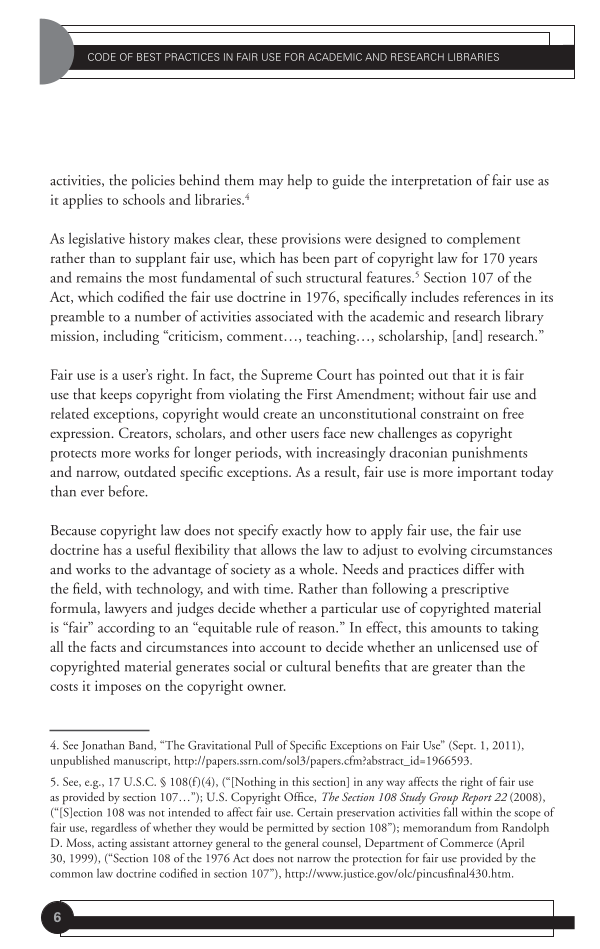CODE OF BEST PRACTICES IN FAIR USE FOR ACADEMIC AND RESEARCH LIBRARIES
6
activities, the policies behind them may help to guide the interpretation of fair use as
it applies to schools and libraries.4
As legislative history makes clear, these provisions were designed to complement
rather than to supplant fair use, which has been part of copyright law for 170 years
and remains the most fundamental of such structural features.5 Section 107 of the
Act, which codified the fair use doctrine in 1976, specifically includes references in its
preamble to a number of activities associated with the academic and research library
mission, including “criticism, comment…, teaching…, scholarship, [and] research.”
Fair use is a user’s right. In fact, the Supreme Court has pointed out that it is fair
use that keeps copyright from violating the First Amendment without fair use and
related exceptions, copyright would create an unconstitutional constraint on free
expression. Creators, scholars, and other users face new challenges as copyright
protects more works for longer periods, with increasingly draconian punishments
and narrow, outdated specific exceptions. As a result, fair use is more important today
than ever before.
Because copyright law does not specify exactly how to apply fair use, the fair use
doctrine has a useful flexibility that allows the law to adjust to evolving circumstances
and works to the advantage of society as a whole. Needs and practices differ with
the field, with technology, and with time. Rather than following a prescriptive
formula, lawyers and judges decide whether a particular use of copyrighted material
is “fair” according to an “equitable rule of reason.” In effect, this amounts to taking
all the facts and circumstances into account to decide whether an unlicensed use of
copyrighted material generates social or cultural benefits that are greater than the
costs it imposes on the copyright owner.
4. See Jonathan Band, “The Gravitational Pull of Specific Exceptions on Fair Use” (Sept. 1, 2011),
unpublished manuscript, http://papers.ssrn.com/sol3/papers.cfm?abstract_id=1966593.
5. See, e.g., 17 U.S.C. § 108(f)(4), (“[Nothing in this section] in any way affects the right of fair use
as provided by section 107…”) U.S. Copyright Office, The Section 108 Study Group Report 22 (2008),
(“[S]ection 108 was not intended to affect fair use. Certain preservation activities fall within the scope of
fair use, regardless of whether they would be permitted by section 108”) memorandum from Randolph
D. Moss, acting assistant attorney general to the general counsel, Department of Commerce (April
30, 1999), (“Section 108 of the 1976 Act does not narrow the protection for fair use provided by the
common law doctrine codified in section 107”), http://www.justice.gov/olc/pincusfinal430.htm.
6
activities, the policies behind them may help to guide the interpretation of fair use as
it applies to schools and libraries.4
As legislative history makes clear, these provisions were designed to complement
rather than to supplant fair use, which has been part of copyright law for 170 years
and remains the most fundamental of such structural features.5 Section 107 of the
Act, which codified the fair use doctrine in 1976, specifically includes references in its
preamble to a number of activities associated with the academic and research library
mission, including “criticism, comment…, teaching…, scholarship, [and] research.”
Fair use is a user’s right. In fact, the Supreme Court has pointed out that it is fair
use that keeps copyright from violating the First Amendment without fair use and
related exceptions, copyright would create an unconstitutional constraint on free
expression. Creators, scholars, and other users face new challenges as copyright
protects more works for longer periods, with increasingly draconian punishments
and narrow, outdated specific exceptions. As a result, fair use is more important today
than ever before.
Because copyright law does not specify exactly how to apply fair use, the fair use
doctrine has a useful flexibility that allows the law to adjust to evolving circumstances
and works to the advantage of society as a whole. Needs and practices differ with
the field, with technology, and with time. Rather than following a prescriptive
formula, lawyers and judges decide whether a particular use of copyrighted material
is “fair” according to an “equitable rule of reason.” In effect, this amounts to taking
all the facts and circumstances into account to decide whether an unlicensed use of
copyrighted material generates social or cultural benefits that are greater than the
costs it imposes on the copyright owner.
4. See Jonathan Band, “The Gravitational Pull of Specific Exceptions on Fair Use” (Sept. 1, 2011),
unpublished manuscript, http://papers.ssrn.com/sol3/papers.cfm?abstract_id=1966593.
5. See, e.g., 17 U.S.C. § 108(f)(4), (“[Nothing in this section] in any way affects the right of fair use
as provided by section 107…”) U.S. Copyright Office, The Section 108 Study Group Report 22 (2008),
(“[S]ection 108 was not intended to affect fair use. Certain preservation activities fall within the scope of
fair use, regardless of whether they would be permitted by section 108”) memorandum from Randolph
D. Moss, acting assistant attorney general to the general counsel, Department of Commerce (April
30, 1999), (“Section 108 of the 1976 Act does not narrow the protection for fair use provided by the
common law doctrine codified in section 107”), http://www.justice.gov/olc/pincusfinal430.htm.


































